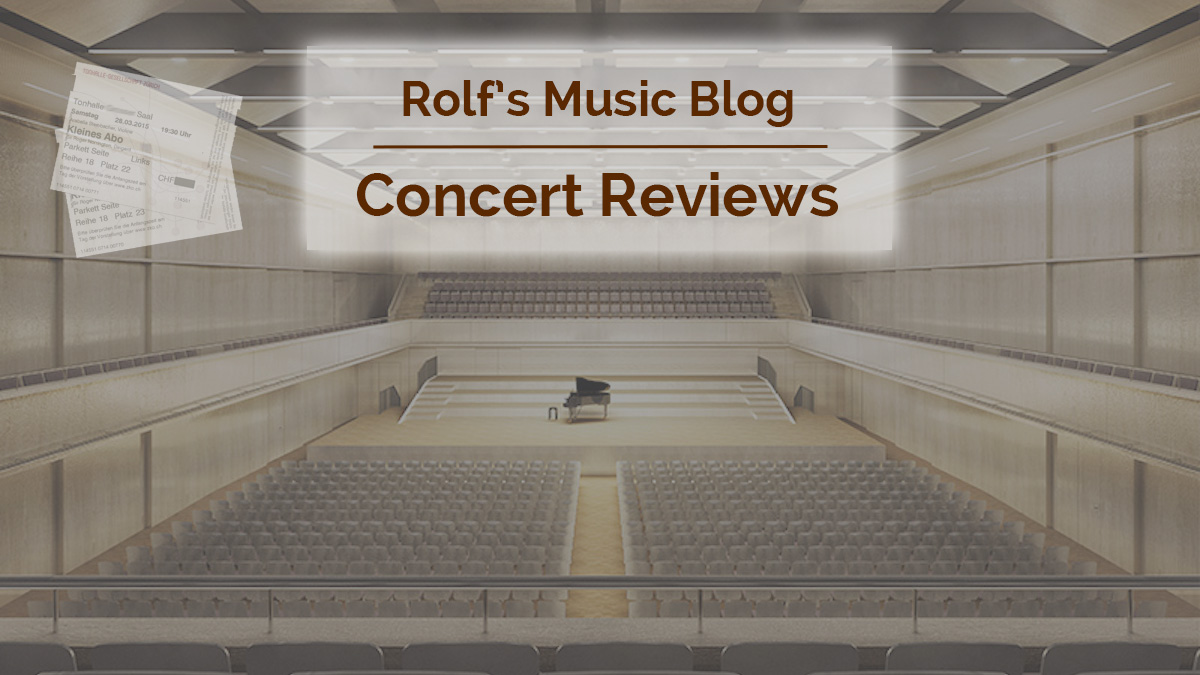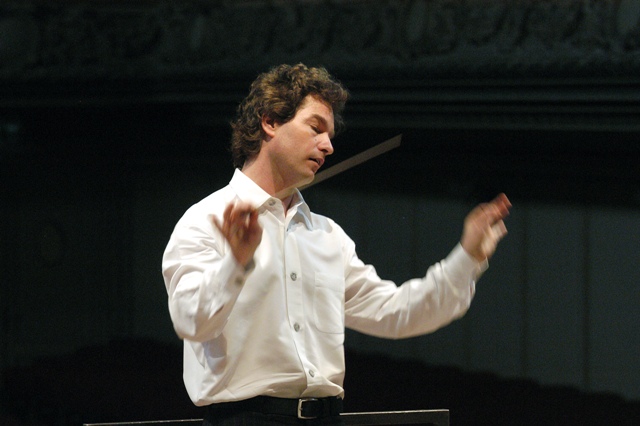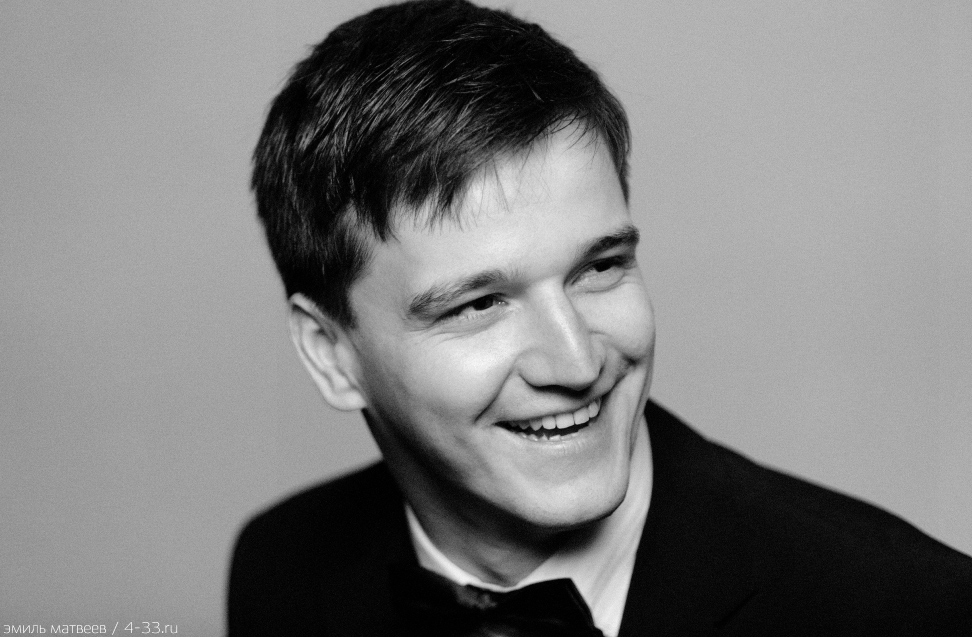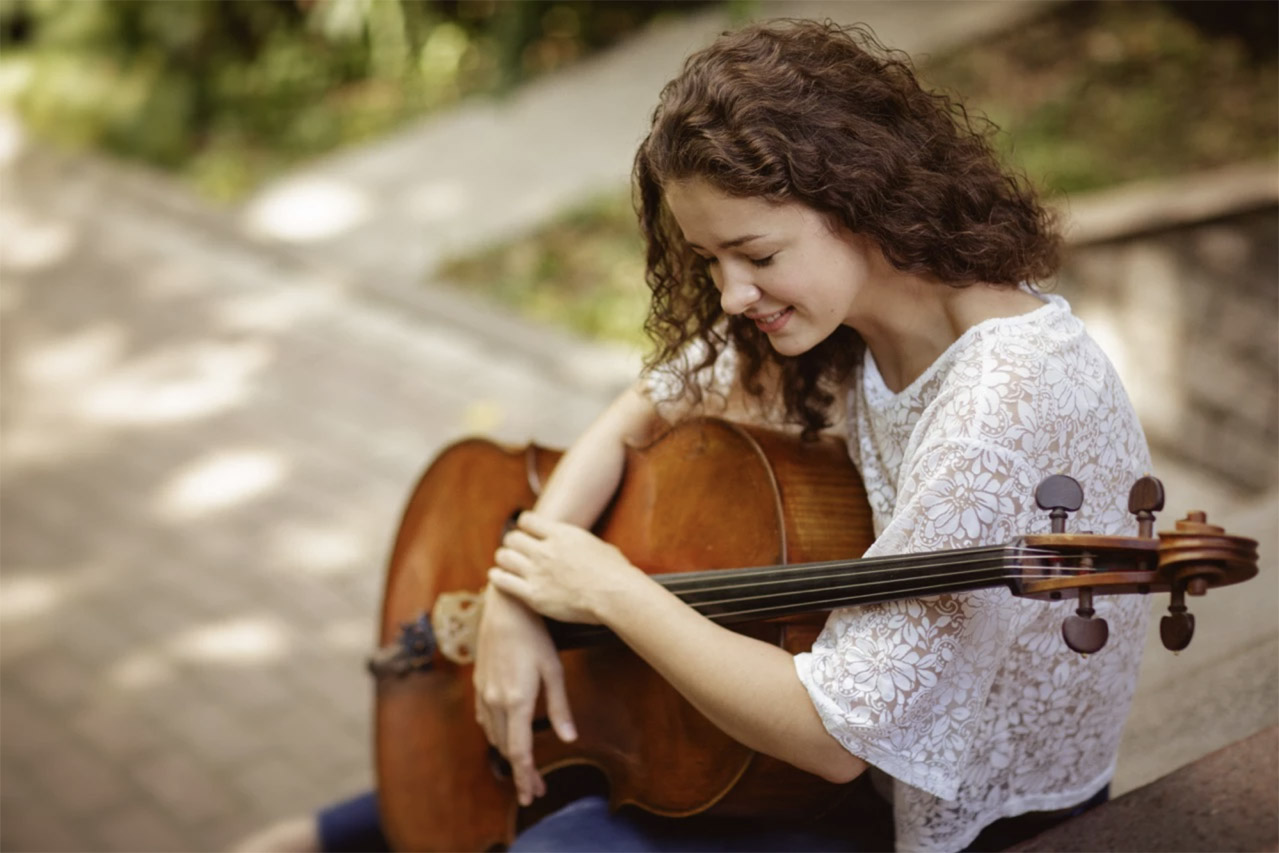Aleksandr Shaikin, Anastasia Kobekina, Heiko Mathias Förster / Zürcher Symphoniker
Mendelssohn / Chopin / Schumann / Beethoven
Tonhalle Maag, Zurich, 2018-07-02
2018-07-08 — Original posting
2018-07-10 — Added 3 images from the performance
Zu hoch gegriffen: Die Zürcher Symphoniker unter Heiko Mathias Förster mit vielversprechenden Jungstar — Zusammenfassung
Anastasia Kobekina präsentierte sich in Schumanns spätem Cellokonzert in a-moll, op.129, als gefestigte, überzeugende musikalische Persönlichkeit. Aleksandr Shaikin gelang es weniger, sich in Chopins Klavierkonzert Nr.2 in f-moll, op.21, unter der kaum differenzierten Begleitung der Zürcher Symphoniker freizuspielen. Das Orchester unter Heiko Mathias Förster arbeitete auch in der Ouvertüre zu Mendelssohns “Sommernachtstraum” und in Beethovens Sinfonie Nr.8 an der Grenze der Überforderung.
Table of Contents
Introduction
The Orchestra
Zurich probably has too many competing orchestras. There are the two local favorites, the Tonhalle Orchestra Zurich and the Philharmonia Zurich at the Opera, plus—according to a news article two years ago—at least five more that are at least partly competing for the same or similar audiences. Some of these “extra” orchestras are chamber orchestras with a (partly) different repertoire. But there are also additional, full symphony orchestras in this mix. One of these are the Zürcher Symphoniker. That orchestra emerged in 1981 under the name “Symphonisches Orchester Zürich” (Symphonic Orchestra Zurich). It was the conductor Daniel Schweizer (*1953, see also Wikipedia) who founded the ensemble.
The orchestra went through a major crisis, ended in a commercial failure. 2015, it re-emerged under its current name Zürcher Symphoniker. The principal conductor of the professional ensemble is Mario Beretta (*1942).
A Romantic Gala Concert?
This concert (one of two on subsequent days) ran under the name “Gala-Konzert der Romantik“. I was curious to see what the term “Gala” meant in this case: typically, this implies festive dress style, speeches, high ticket prices, long breaks or a post-concert standing buffet. The concert did start an hour early, the ticket prices may have been above average, but none of the other ingredients took place. The event was sold out. So, at least, it should not have been a commercial failure.
I see the title “Gala Concert” as the orchestra’s attempt to show profile, to present itself as competitive in the marketplace. The program of the evening also reflected this:
- Mendelssohn: Overture “A Midsummer Night’s Dream”, op.21
- Chopin: Piano Concerto No.2 in F minor, op.21
- Schumann: Cello Concerto in A minor, op.129
- Beethoven: Symphony No.8 in F major, op.93
Beethoven doesn’t really fit to the term “Romantic”, and even in the case of Mendelssohn’s overture, this attribution is questionable. But whatever—it’s just a title…
For the orchestra, the one aspect which probably lifted this concert above the ensemble’s regular ones is, that not Mario Beretta was conducting, but guest conductor Heiko Mathias Förster. The latter also conducted the concert on the following day. In the same vein, for this concert, two young, talented soloists, Aleksandr Shaikin and Anastasia Kobekina, were hired—I’m introducing these below, with the works that they performed.
The Conductor
Heiko Mathias Förster was born 1966 in Crivitz, in East Germany back then. I have previously written about a concert with this conductor: on 2015-02-15, he conducted the Staatskapelle Halle (State Orchestra in Halle / Saxony-Anhalt) in Zurich’s Tonhalle. See my concert report for additional information.
Concert & Review
Mendelssohn: Overture “A Midsummer Night’s Dream”, op.21
Felix Mendelssohn Bartholdy (1809 – 1847) was just 17, when in 1826 he wrote his Concert Overture “A Midsummer Night’s Dream”, op.21—a work that has firmly established itself in concert programs ever since. In 1842, 16 years later, that overture became part of the Incidental Music to Shakespeare’s play “A Midsummer Night’s Dream”, op.61. With its continuous fast quaver sequences in the violins, this is a popular orchestral showpiece.
The Performance
Interestingly, in this “Gala Concert”, the orchestra size seemed somewhat reduced, compared to the pictures and artist listings on their Web site. The latter shows around 40 string players, but here there were only around 30. This did have an effect on the performance, see below.
For the orchestra, the choice of repertoire in this concert was ambitious, to say the least. This was obvious already in Mendelssohn’s overture: as typical for the young Mendelssohn, the overture is full of relentless, fast quaver movement. These quavers didn’t “fall apart”, but they didn’t exhibit the necessary / desirable clarity. In other words: the coordination was somewhat marginal, despite Heiko Mathias Förster’s ultra-clear, accurate and concise conducting. The latter was so clear that it made me think of Prussian-military command/sign language (not infrequently he used harsh, Karate-like arm movements to address specific musicians, to initiate actions).
Rhythmically, Förster certainly kept the orchestra together, even though the strings occasionally tended to lag a tad behind. Throughout the concert, the conductor made no concessions whatsoever in the tempo. One should think that fewer string players would facilitate the coordination, the precision. Here, however, the primary effect of the smaller string setting was that the brass section (trombones, even more so the tuba) were often dominating the soundscape. Sadly, this persisted throughout the concert. Apart from the balance issue, and with the exception of momentary intonation issues with the clarinets, the wind instruments were performing fine—the best part of the orchestra.
Rating: ★★½
Chopin: Piano Concerto No.2 in F minor, op.21
Frédéric Chopin (1810 – 1849) composed what we now know as Piano Concerto No.2 in F minor, op.21 in 1829—one year prior to his Concerto No.1 in E minor, op.11. However, the composer published these concertos in reversed order, hence the No.2 and the higher opus number. This concerto has three movements:
- Maestoso
- Larghetto
- Allegro vivace
I have posted a detailed comparison of several recordings of this concerto, therefore see that earlier posting for details on the composition.
The Soloist: Aleksandr Shaikin
The Russian pianist Aleksandr Shaikin (see also the Web site of the Géza Anda Foundation) was born 1987. He had key parts of his education from the Gnessin School of Music in Moscow, later from the Tchaikovsky State Conservatory in Moscow, where he studied with Eliso Virsaladze (*1942), and finally at the Mozarteum Salzburg, with Pavel Gililov (*1950). Shaikin’s career had a boost since he won the second prize at the Géza Anda International Piano Competition in 2015.

The Performance
I. Maestoso
Already the orchestral introduction was a disappointment. One principal flaw was the very obvious tendency to equate “louder” with “faster”. I have rarely noted that bad habit stand out so clearly. If one wanted to tie tempo changes to dynamics, then the opposite (louder = slower) would seem more logical (though still questionable as a general “rule”). Not only were these tempo alterations rather odd and arbitrary—they also turned out a tough challenge for the orchestra: the coordination was rather shaky in these segments.
And the brass instruments (trombones, tuba) again were consistently too loud (occasionally, I had the impression of a concerto for piano, brass band and orchestra!). Already at the ff in bars 19 – 22, the tuba not only dominated over all other instruments, but it also pulled ahead. Later, the tempo alterations also affected the coordination with Aleksandr Shaikin.
Solo
Naturally, with the entry of the solo piano, the attention partly turned away from the orchestra. Aleksandr Shaikin’s appearance was unpretentious, modest, almost inconspicuous. He made no or little attempts to dominate acoustically or visually, even rarely interacted with the orchestra visibly. Rather, Shaikin stayed concentrated on the keyboard, on his playing. I would characterize his performance was focusing on the musical flow, more than on agogics and finely detailed articulation. Undoubtedly, Aleksandr Shaikin’s technical prowess allowed him to make the concerto sound easy, despite occasional dropped or missed keys. Runs and scales were smooth, fluent, often elegant, occasionally standing out in brilliance. Shaikin’s rubato was mindful and emotionally shaped, his playing generally differentiated.
★★ (Orchestra) / ★★★ (Solo)
II. Larghetto
More than in the first movement, the Larghetto gave Aleksandr Shaikin to stay in control, to have a chance to form his solo part more freely, to let the cantilenas sing. He used rubato and free agogics to shape lines and scales, and towards the end I noted a really harmonious dialog with the bassoon. With the exception of a few notes on the horns, the accompaniment features no brass instruments—which certainly helped making this the best movement in the performance.
★★½ (Orchestra) / ★★★ (Solo)
III. Allegro vivace
The tempo in the final movement was rather fresh—no problem for Aleksandr Shaikin (who was setting the pace), but for the orchestra, it was clearly at the limit, where things started to sound superficial. There was little or no time for agogics in the accompaniment, the coordination between soloist and orchestra was far from ideal. Also within the orchestra, not everything went smoothly: for example, the ritardando prior to the modulation fo F major was shaky, As in the initial overture, there were again occasional intonation issues in the clarinets.
★★ (Orchestra) / ★★★ (Solo)
Overall, I don’t think that Aleksandr Shaikin was able to present his abilities adequately in this evening’s constellation. To claim that the accompaniment was sensitive and emphatic towards the young soloist would be a gross overstatement.
Overall Rating: ★★ (Orchestra) / ★★★ (Solo)
Schumann: Cello Concerto in A minor, op.129
The Cello Concerto in A minor, op.129 by Robert Schumann (1810 – 1856) is a composition from 1850: Schumann wrote it soon after becoming music director in Düsseldorf. I have posted a comparison of several recordings of this concerto—for details on the composition see that earlier posting. Let me just list the movements here:
- Nicht zu schnell (not too fast)
- Langsam (slow)
- Sehr lebhaft (very lively)
I have also written about this concerto in the review on an earlier concert in Bern, on 2017-05-18.
The Soloist: Anastasia Kobekina
This was the second time that I encountered the promising, young cellist Anastasia Kobekina in concert: my first encounter was just a few weeks ago, in a concert in Uster, on 2018-05-17. Previously, I hadn’t even heard about the artist (shame on me!). Anastasia Kobekina was born 1994 in Ekaterinburg. For details on her curriculum see her Web site. A short excerpt is also available in my earlier concert report.

The Performance
I. Nicht zu schnell
Anastasia Kobekina greatly profited from the fact that Schumann’s cello concerto largely lives out of the solo part, right from the beginning (Aleksandr Shaikin hadn’t been so lucky in that respect). Her part begins in bar 5 already, and she immediately seized the control, determined the course of the music. Her playing was full of expression, life and emotion, in every single note, her tone full, round, warm, the intonation firm, flawless. Without doubt, Anastasia Kobekina is a consolidated musical personality, amazingly strong for her 24 years. Here, the orchestra plays a minor role (thanks to Robert Schumann, I should say) and didn’t affect the almost overwhelming impression that the soloist left from this movement.
★★½ (Orchestra) / ★★★★½ (Solo)
II. Langsam
With some artists, this movement appears to express forlornness, pain, despair in utter loneliness. One can certainly justify this view from the composer’s biography. However, alternative view may be legitimate as well (e.g., the movement as retrospective view, memories of a happy past, of times full of love and emotion, etc.).
Unaffected by the somewhat indifferent accompaniment, Anastasia Kobekina’s very touching interpretation turned this movement into a heart-warming gem! Not loneliness dominated the music, but the most intense emotions, warm feelings, longing and tension, bridging the gaps, those rests which may otherwise appear scary, like dark abysses.
★★½ (Orchestra) / ★★★★½ (Solo)
III. Sehr lebhaft
There wasn’t much subtlety in the way how the orchestra performed the transition to the final movement. So, it was no surprise that the tempo was on the fast side—too fast for the orchestra. The accompaniment felt pushed, coarse, superficial, often “wooden”, lacking rhythmic flexibility, leaving the listener somewhat breathless. Despite her technical mastership and superiority, the soloist at this pace didn’t have much of a chance to articulate and shape details (e.g., with agogics). Here, I wished for a more relaxed (less pushed), if not somewhat playful approach.
★★ (Orchestra) / ★★★½ (Solo)
Overall Rating: ★★½ (Orchestra) / ★★★★ (Solo)

Beethoven: Symphony No.8 in F major, op.93
Ludwig van Beethoven (1770 – 1827) wrote his Symphony No.8 in F major, op.93 in 1812. The symphony is in the usual four movements:
- Allegro vivace e con brio
- Allegretto scherzando
- Tempo di menuetto
- Allegro vivace
As the symphony is so well-known, I’ll refrain here from adding further comments on the composition.
The Performance
I. Allegro vivace e con brio
In the absence of the “distraction by a soloist”, we were back to “down to the orchestra”—and the issues already observed in the overture: dominance of the brass instruments, oddities in the tempo disposition, and a somewhat careless, rather superficial interpretation altogether. The tempo was rather fast, there was no rhythmic elasticity, little, if any agogics (never any “dancing”). Accents were hard, if not harsh, and there was no emotional warmth. The ending felt somewhat helpless, lacked definition. Needless to say that the exposition was not repeated.
II. Allegretto scherzando
This symphony doesn’t have a truly slow movement. All the more it would be important to play this part with subtlety, relayed, playfully. I missed the scherzando aspect (the tempo probably was too fast). And more string instruments would have helped balancing the soundscape.
III. Tempo di menuetto
The Menuetto was somewhat heavy, certainly not playful, let alone “dancing”—still, I found it to be the best movement so far. In the Trio, the wind instruments (especially the horns) were once again too loud, relative to the strings.
IV. Allegro vivace
The tempo may not have been dramatically fast—still, it often felt pushed, the orchestra was operating at a point, where the coordination often suffered. The musicians probably also felt the length of the evening. And Heiko Mathias Förster was rather accelerating, and there was no time for subtlety or careful articulation, phrasing and dynamics.
Rating: ★★½
Conclusions
Based on the performance, the program / repertoire seemed too ambitious for the orchestra. On top of that, Heiko Mathias Förster was conducting a different program with the orchestra on the following day. One can only speculate that the rehearsal time must have been rather limited.
I did not envy the two soloists in this concert:
- At the beginning of a career, it seems hard, if not impossible to decline concert opportunity, especially if a core piece of one’s repertoire can be performed (and even more so if one is eager, maybe desperate to fill gaps in the concert schedule);
- it may be difficult to anticipate whether a concert opportunity will offer conditions that help furthering one’s career, i.e., whether it will permit presenting one’s prowess and capabilities adequately. A good agency can certainly help—but before they have established themselves in the market / the concert scene, young artists often have to rely upon minor concert agencies (if they have an agent at all!).
Aleksandr Shaikin didn’t fare that well with the given accompaniment—he would have needed (and deserved) better conditions to present his artistic abilities.
Anastasia Kobekina, on the other hand, offered a superb performance and largely mastered the challenges of the concert situation well. She was the true highlight of the evening!
Addendum
For this concert I have also written a (shorter) review in German for Bachtrack.com. This posting is not a translation of the Bachtrack review, the rights of which remain with Bachtrack.com. I created the German review using a subset of the notes taken during this concert. I wanted to enable my non-German speaking readers to read about my concert experience as well. Therefore, I have taken my original notes as a loose basis for this separate posting. I’m including additional material that is not present in the Bachtrack review.




